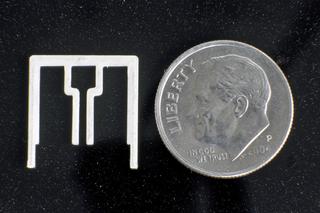Deconstructing Aereo's Patent
PHILADELPHIA—To receive TV broadcasts, you need some sort of antenna. And that antenna can’t just be a paper clip or coat hanger, although both can work sometimes. The antenna must have some physical relationship to the wavelength of the signal being received. If it does, it approaches resonance and transfers the maximum level of signal to a receiver.
We know the relationship between wavelength and frequency. They’re inversely proportional to each other, and a quick way to determine the wavelength is to divide the frequency into 300. Example: The wavelength of a TV broadcast signal on Ch. 2, broadcasting at about 55 MHz, is about 5.45 meters. If you could actually see the radio wave, one complete cycle of the signal would measure 5.45 meters, or almost 18 feet.
In order for our antenna to resonate—i.e., have gain at the desired frequency—it needs to have some fractional relationship to the wavelength. So, a full-wave loop for Ch. 2 would measure 18 feet. A ½-wave dipole would then measure 9 feet, while a ¼-wave whip antenna would measure about 4.5 – about 54 inches.
That’s not to say that our Ch. 2 antenna wouldn’t work at other frequencies. It could also pull in signals at Ch. 3, or 4, or even 5 and 6. But it wouldn’t be as efficient at those frequencies as it would on Ch. 2.
The same principle holds true for high-band VHF Ch. (7-13). To pull in Ch. 7, broadcasting at about 176 MHz, we’d like to have an antenna with a full wavelength of 5.6 feet. A ½- wave antenna would then measure about 2.8 feet, and a ¼-wave whip antenna would measure about 1.4 feet, or 17 inches.
For UHF TV channels, let’s pick 600 MHz (TV Ch. 36) for our example. A full wavelength here is 1/2 meter, or about 19 inches. A ½-wave antenna would then be 9.5 inches and a ¼-wave whip antenna, such as you’d find on wireless microphone systems, would measure slightly less than 5 inches.
Again, that’s not to say the ¼-wave or ½-wave antennas mentioned wouldn’t work on higher or lower UHF TV channels. It’s just that they’re most efficient at 600 MHz. All of this is just basic physics and innate knowledge to anyone who has worked with RF antenna and transmission systems, amateur or professional.
Get the TV Tech Newsletter
The professional video industry's #1 source for news, trends and product and tech information. Sign up below.

Each individual “antenna” in the Aereo system is about the size of a dime.

Here is a cross-sectional view of the tiny antenna elements in place.
Now, let’s look at the Aereo antenna. It’s about the size of a dime and resembles a small loop antenna. Just looking at it in a photo and keeping in mind the science you just read, it would be impossible for such a small antenna to have any resonance or gain on low-band VHF TV channels, let alone high-band TV channels.
Yet, that is precisely what Aereo seems to be claiming: One subscriber can activate one of these antennas to watch WABC on Ch. 7 in New York, or WNET on Ch. 13. And I don’t see how these tiny little pieces of metal can even work on UHF TV channels: They’re just too small.
Granted, if they were close enough to the transmitting antenna atop the Empire State Building—like a few hundred feet away – the signal levels would be so strong that they would “brute force” their way through the antenna system. But functioning as standalone antennas a few miles away? Not very likely.
Now, here’s where things get tricky and the boundaries between engineering and law become blurred. Aereo installs these tiny antennas in close-spaced arrays on circuit boards. Thanks to the laws of antenna physics, that close spacing guarantees that adjacent antennas interact with each other. That’s due to the principles of inductive and capacitive coupling.
And that means the thousands of smaller, individual antennas couple energy together to act like a larger antenna; one that will approach resonance and have some gain at the desired reception frequencies.
No matter how you switch the antennas, they do interact; it is simple science. And that appears to be the secret sauce behind what Aereo is doing: Creating large “virtual” antenna arrays made up of thousands of tiny, individual antenna elements that, taken together, make up a large, directional antenna array.
According to the patent application, the individual antennas can be switched on the fly to individual receivers, depending on which ones are in use and which aren’t. So the company can claim that each tiny segment of the antenna is actually a stand-alone antenna, assigned to one subscriber. (Note that, in some earlier Aereo press releases and news stories, they do mention that subscribers can “lease” one or more antennas as needed to pull in a signal. )
THE BASICS – RF, VIDEO, AND MPEG DISTRIBUTION SYSTEMS
Now, if all Aereo was doing was providing thousands of tiny antennas that actually interact to form a large, steerable antenna array, that would be interesting enough. But an Aereo subscription also comes with a “personal” cloud DVR, sitting on a server somewhere on Aereo property.
That means the following must happen for you and me to watch Aereo’s service on our iPhones. (a) A signal must be received from a TV station – say, WABC on Ch. 7 in New York. (b) That RF signal on Ch. 7 must then be demodulated by a receiver and converted from the 8-VSB modulation format to a baseband video signal, or at least an MPEG-2 stream with video, audio, and metadata. (c) The baseband video signal or MPEG-2 stream has to be re-encoded or transcoded to MPEG4 H.264 for transport. (d) The H.264 signal is then encapsulated with IP headers and travels to your home network and device.
That takes a lot of hardware. In a conventional master antenna TV system (MATV), one or more antennas are installed on an apartment building or office and one or more amplifiers go with it to distribute the RF signals from the antenna to multiple users. Is this a public performance? From my perspective, no, as the antenna system is merely passing along whatever channels can be received with it. The end-user determines what channels to watch and when. This is a perfect example of a “rented” or “leased” antenna system.
In contrast, a community antenna TV system (CATV, or cable TV) uses large antennas to capture broadcast signals and subsequently demodulates then to baseband video or MPEG, then re-broadcasts them on the same or different channels with a new program guide. In today’s digital world, your cable TV provider has encrypted these local channels, meaning you must lease or buy a compatible set-top box to watch them.
That is indeed a retransmission and a “public performance” in the eyes of copyright law. The CATV company charges for its service and sometimes inserts local ads on those channels. So they provide not only a remote antenna system, they also add in a DVR service, their own program guide, and encryption.
This is why broadcast TV stations and networks have largely given up on the old FCC “must carry” rules and now demand a retransmission fee for their content, just the same way HBO, Showtime, and ESPN do. It’s today’s business model, and it is threatened by what Aereo is doing.
For Aereo to have a 100 percent, true-blue, subscriber-controlled “antenna system,” they would need individual antennas, receiver/decoders, and encoders for every subscriber. That would amount to thousands of discrete pieces of hardware and an enormous capital outlay they’d never hope to recover at $8 per month. Their patent describes a way to assign each antenna to a separate tuner to demodulate the video stream to MPEG2. That might work fine for a handful of viewers. But what if 10,000, 20,000, or 100,000 subscribers are watching at once?
There’s a reason why cable TV companies use single receivers for each channel at their head ends: It’s the only cost-effective way to provide service. And they use multiplexers to route more than one IP video stream to customers for the same reason. It is a classic “one serving many” model and a cash cow for the likes of Comcast, Time Warner and Cablevision.

This diagram from the Aereo patent filing clearly shows that, at some point, multiple streams of decoded MPEG-2 video programs are mixed together and transmitted from the rooftop antenna systems to the MPEG-4 transcoders in the basement.
OK, so let’s buy the argument that Aereo uses a few receivers as needed for each subscriber to pull in TV channels and perform the usual RF-to-video-MPEG conversion. But then, according to their patent application, they combine multiple MPEG-2 streams into a multiplex (or “mux”) to send them from the roof of the building to the basement for transcoding to MPEG4 H.264 and ultimately, transmission to each subscriber over an Internet connection.
Combining those MPEG-2 streams is really no different than multiplexing TV channels in a piece of coaxial cable delivered to your home. Note that, unlike our MATV example, the TV channels don’t exist in their original 8-VSB format. They’ve been converted (altered) to another format for delivery to the viewer.
Note also, in the area between the MPEG-2 Mux and Demux, the words “Antenna Transport (N x 10GBase).” Here is where Aereo’s entire argument falls apart: You can’t receive an MPEG-2 stream with an antenna; only a modulated RF channel. Calling a 10 Gigabit Ethernet connection that streams MPEG-2 digital video an “antenna transport” is disingenuous. The signal has to be converted to a new format to travel over this part of the network, and as I just pointed out, it is now a bunch of MPEG-2 video programs combined together in one stream for efficiency…just like a CATV or DBS service provider would do at their head end.
In contrast, an MATV system simply receives, amplifies, and distributes RF channels intact to two or more viewers. Those RF signals aren’t demodulated or transcoded – they are delivered in their original state to the viewer. The actual demodulation and decoding happens in each individual TV set.
What’s even stranger is that Aereo is now calling everything ahead of the mux an “antenna.” Horsefeathers! Antennas are antennas; receivers and demodulators are receivers and demodulators. Separate and distinct. That’s as absurd as calling a car an “engine,” or a house a “roof.”
For Aereo to truly provide the service they claim they do, they’d need individual hardware and software processing for every subscriber. No more than one TV channel could travel at the same time to a tuner, and no more than one video program at a time could pass to an encoder, especially not in a multiplexed stream. That improbable and wildly expensive set-up would be a true “leased” antenna and reception system, controlled by the subscriber.
If at any time TV channels, baseband video, or MPEG streams are combined together during the process, then it’s a a CATV system. Pure and simple.
SUMMING UP
Again, let me say that I don’t want to delve into the copyright and business model issues with regards to Aereo. I’ll leave that to the lawyers. Instead, I’m solely focusing on the science of what Aereo does, and to me, it’s overly clever engineering, attempting to re-define the term “antenna” and parse legal terminology.
Their entire argument for getting away with retransmitting broadcast TV content rests on those thousands of individual antennas, which as we’ve learned, unquestionably interact with each other and are separate antennas in name only. The rest of the system appears to be more conventional, with receivers, MPEG streams mixed together, and MPEG transcoding – just like a cable TV does, or even an IPTV multichannel provider, like AT&Ts U-Verse.
The puzzler is why the plaintiffs—TV stations and networks—didn’t pursue this technical angle more aggressively in the first place. In the first court case, at least one judge— Denny Chin of the U.S. Court of Appeals for the Second Circuit—called Aereo’s system a “Rube Goldberg” approach, cleverly designed to circumvent copyright law. He hit the nail on the head. There was some testimony from an RF expert at the first hearing, but either the testimony wasn’t presented correctly or contained technical flaws. So the copyright violation angle has been pursued exclusively by plaintiffs since then.
The judge for the 10th Circuit in Salt Lake City, Dale Kimball, stated in his February decision that “Aereo’s retransmission of plaintiffs’ copyrighted programs is indistinguishable from a cable company.”Kimball got it right as well, as did the three-judge panel that subsequently upheld Kimball’s injunction.
See Pete’s original post, including his pedigree, at HDExpert.com.
See Aereo’s patent application.
Pete Putman, CTS, KT2B, is the president of ROAM Consulting.

